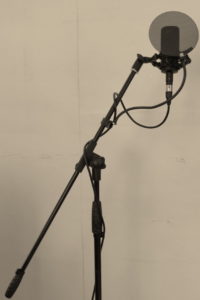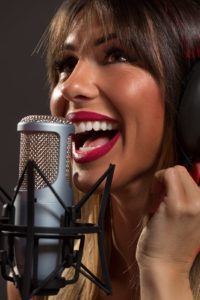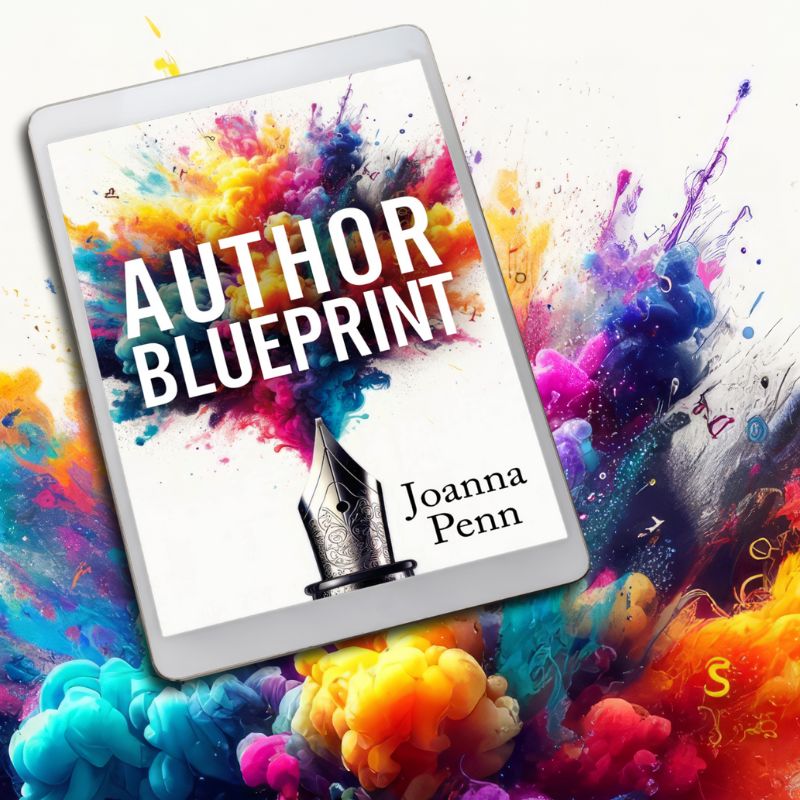If you want to be a successful author, then at some point, you are going to have to do an audio recording.

My show, The Creative Penn podcast, has become the cornerstone of how I connect with my readers and help people with interviews and inspiration on the writing life. I interview a lot of people and it's incredible how many authors don't have a professional audio setup.
Audio is only going to be more common for your book marketing, so take it seriously if you are going to appear on a podcast or radio show. Today's article by Dan Van Werkhoven will help you improve your audio setup. Dan is my sound guy for The Creative Penn podcast so I can highly recommend him!
Marketing books is hard. There are dozens of marketing methods to choose from, some of which require recording your voice.
Things like:
- Reading a chapter from your book as a lead magnet to give to newsletter subscribers
- Recording a blurb for a book trailer
- Recording live videos for fans
- Recording your novel and releasing it bit by bit as a podcast
- Running a podcast to promote your non-fiction
The list goes on.
Today, for simplicity’s sake. I’m going to focus on one area of audio: podcasting. But never fear! These tips are universal. You can use them to dramatically improve the quality of your audio no matter which audio marketing method you choose.
If you’re short on time and just want an action plan, skim through and only read the numbered headlines and the What sections. The Why sections are for those who want to, well, know why I recommend something.
If you haven't already, I recommend reading Joanna’s post on how to podcast. It covers the basics and is a great place to start. If you’ve already read it or have the basics covered, read on!
Understand your audience
This isn't a tip, per se, but knowing what your audience wants/needs helps you understand what you're trying to achieve with your audio recording.
So, I’m an avid listener of podcasts. I listen while cleaning the house, doing dishes, cooking, and running. And I know I’m not alone, many people listen to podcasts while doing other tasks. This means that often the podcast might be playing through speakers across the house. Or their hands are dirty/occupied and they can’t get to the volume control on their phone.
In short, they can’t change the volume easily or quickly.
The best podcast listening experience comes from clear, easily understood dialogue with no sudden loud noises and no quiet sections. The listener should never feel the need to turn the volume up. Or sprint across the house because the podcast got obnoxiously loud again, and their neighbour is calling the police because they’re sick of the noise.
If you’re a podcast host—or being interviewed on a podcast—you want to give your audience the best possible experience.
So the tips today are on how to achieve consistency and clarity with your audio. This will help give your audience a smooth, pleasant listening experience.
Now finally! The tips!
1. Invest in a microphone
What: If you’ve read Joanna’s post, you’ve seen her recommend something like the AudioTechnica ATR2100 USB Microphone or the Blue Yeti USB Microphone. These are good choices. They’re USB so you don’t need another interface to plug it into, and both sound decent. Of the two, I’d recommend the Yeti as the sound quality is higher.
Grab a nice mic and you’re well on your way to achieving clarity with your audio. Both work on Mac and Windows.
Why: You might be wondering why your laptop microphone isn’t enough, or why you shouldn’t use your headset’s built-in mic. It works fine for phone calls, so why not for your podcast, right? Or for being interviewed on someone else’s podcast?
A quick lesson on microphone types.
Your laptop and headset mic (most often) have what’s known as an omnidirectional pickup pattern. This means they pick up sound in all directions. This is bad for professional-sounding audio because you get more background noise. More noise = bad.
But, worse, it’ll pick up the sound of your voice bouncing off your computer screen, your walls, and any hard surface in the room. It makes the audio have more reverb. (To understand what reverb sounds like in the extreme, clap your hands in a cave or a cathedral). Reverb is very, very difficult (difficult = expensive) to remove.
Most mics (like the Yeti and the ATR2100) have a cardioid pickup pattern. This basically means that sound that happens behind the microphone isn’t picked up so well. You need to be in front of it and speaking towards it for the best quality sound. This is great because it means the mic picks up less computer fan noise. And in contrast to an omnidirectional mic, it picks up less echo/reverb from your voice bouncing off hard surfaces.
Add to all that, unless you spend many hundreds of dollars on a headset, the microphone in it isn’t going to be as good a quality as a budget Yeti or ATR2100.
But… even the best mic in the world isn’t enough to save the day. It’s not how much it costs, it’s how you use it.
So, onwards!
2. Wear headphones/earbuds
What: Wear headphones or earbuds when audio is being recorded—whether you’re recording your own podcast or you’re being interviewed.
Why: As soon as you have audio coming out your speakers, the microphone will pick it up and things sound messy. This will kill clarity. The result is strange echoes in the audio, or worse, feedback.
Feedback is that high-pitched whine you hear in every movie when someone taps on the microphone at a conference. Feedback is one of the fastest ways to damage your speakers and your mic. Headphones will ensure you never get feedback or echo in your audio (no echo = clarity = happy listeners).
If you’re doing video too you might worry about how it looks. But your listeners will forgive you for wearing large headphones much faster than they’ll forgive you for having messy audio they can’t understand. I’ve stopped listening to podcasts because of this issue. And in reality, most of your listeners will be listening to the audio-only version, not watching the video.
However… if looks are something you need to be concerned about for your video, you can invest in a pair of in-ears. An example would be Shure SE215 Earphones which also come in clear (clear = less visible to camera). The advantage of in-ears is they have a cable which runs up and over your ear and hangs down behind your head. If you’ve ever watched a concert, you’ve seen most of the members of the band wearing in-ears.
3. Position the mic
What:
A. Look at your monitor, or webcam, or whatever you’ll be looking at while you record.
B. Get a ruler and mark the 20cm (8in) point on it.
C. Place the end of the ruler on your chin and swing it 30-45 degrees to the left or right.
D. Place the microphone at the 20cm mark and pointed at your mouth.
If you’re doing an audio only podcast, have the microphone level with your mouth. If you’re on video, you can lower it to chin/throat level so it’s not obscuring your face. At all times have the mic angled directly towards your mouth.
To get the perfect position, you’ll need a mic stand with a boom arm to allow you to move your microphone.

Why: It’s a pretty specific location, hey? There are a few reasons for this particular location.
A. You want the mic off-centre so you don’t breathe on it, laugh on it, or make explosive plosives on it (“puh” sounds). Sound moves air. The louder the sound, the more air it moves. Very roughly speaking. Microphone diaphragms pick up minute movements of air, translate them to voltage fluctuations, then translate those into 1s and 0s and hey presto! You got a recording! What that means, though, is if a strong blast of air (like a laugh) hits the mic, it sounds baaaad.
Like explosion kind of bad.
Your listeners are there for your voice, not explosive audio.
B. The distance is also important. If you get too close to a good mic, all you hear in the recording is the smacking of lips and weird wet sounds. The mic will pick up every mouth movement, every breath, everything.
This isn’t the most fun to listen to. If you’re wearing headphones it’s like having someone breathing in your ear. I don’t know about you, but that kinda creeps me out. Not even my wife is allowed to breathe that near to my ears.
On the flip side, if you get too far away, microphones pick up the room sound more. (Remember that wonderful reverb we talked about which is so expensive to remove?) So about 20cm away will give you a nice balance between the two. And it means the mic is far enough away that you don’t have to worry about bumping it every time you turn your head.
Speaking of head turning…
4. Keep as still as possible
What: Only ever talk when looking straight ahead or at your mic. Don’t look down and talk while fishing for notes. Don’t look over your shoulder and talk. As much as possible, try to maintain the same distance from the mic when you talk.
If you’re in a long interview, and you need to stretch, wait until the other person is talking. Then move around—but do so quietly. The mic hears all! No neck or knuckle cracking unless you’ve muted the microphone. But don’t forget to un-mute if you do!
Also be aware that sneezes, coughs, sniffs and throat clearing are deafening through a microphone. If you need to sneeze while speaking and can’t get to the mute button, now is the time to look away and lean back to minimise the volume and muffle the noise.
Finally, make sure not to touch the microphone, stand, or whatever the stand is sitting on at any point while recording!
Why: Every time you move towards or away from the mic, the volume changes. And as I mentioned earlier, the amount of mouth noise or reverb in the recording changes, too. None of those things are helpful to your listener.
When you look away from the mic, the recording becomes muffled. Imagine trying to clearly understand someone whose back is to you while they talk. It’s hard. Your microphone has the same problem, it can’t hear you properly if you don’t talk towards it.
If you touch your mic stand, you’ll get metallic thumping through the mic. You can minimise this with a shock mount, but best practice is to leave the stand alone while recording.
So try to restrain movement as much as possible to maintain a consistent volume and sound quality.
5. Wear silent clothes and be a ninja!
What: Don’t wear clothes that swish when you move, jewellery that clinks, clanks, or tinkles, watches that rattle, etc. You want to be a ninja when you move.
It’s also best to avoid paper shuffling, typing on the keyboard, or mouse clicking when possible. Try to have all your notes sorted before you begin in order to minimise this. If you need to shuffle papers or click, try to save it for when the other person is talking and mute your mic. Then you can make all the noise you want without disrupting the interview.
As above, don’t forget to un-mute before you talk again!
Why: Mics pick up sound. If you wear noisy clothes or jewellery, the mic will pick up every swish or clink made. Listening to a podcast where there’s a constant jangle in the background can be very distracting.
6. Use a pop filter

Also, if you’re doing an audio-only podcast, it means you can have the microphone positioned directly in front of you at mouth level (though I still recommend having it 20cm away). This is the ultimate position for best audio quality—but only use it when a pop filter is present!
Why: If you have the mic to the side, you won’t get many explosive blasts of air hitting it, but the pop filter will help catch any strays. It’s a good failsafe in case you look at the mic and laugh.
7. Move those lips!
What: Enunciate your words.

Why: When you listen to people talk, most often you can see their lips and that helps you understand them. If you suffer from hearing damage (or are just progressing to the Old and Wise years), the need to see lip movement to understand people becomes increasingly important. Unless the person talking is speaking loud and clear.
With a podcast, the listener can change the loud part—they can turn the volume up when listening. But they can’t do anything about the clear part!
The more you slur your words while you’re podcasting, the louder a listener with less than perfect hearing will have to play the podcast. If they’re listening with headphones, this can lead to more hearing damage. If they’re playing through speakers, this can annoy neighbours.
Speaking clearly is so important because in the world of the internet there are no borders. Languages and cultures mix. Just because I’m an Australian and might do a podcast in Aus, that doesn’t mean everyone listening will be Australian. I need to be careful that my twangy Aussie accent is understandable to someone from the United States. Enunciating words and exaggerating lip movement helps with that.
So be mindful of your listener and do your part to make yourself as clear as possible.
Exercise: Read a script and do a test recording. In the first read-through, talk as you normally do. In the second, exaggerate those lip movements!
Now, listen back and see if you can hear a difference.
It will feel weird to talk like that if you’ve not done it before, but it can help clarity in an audio-only podcast. The difference may only be subtle to you because you know what you’re saying, but it can make a world of difference to a stranger from a different country.
8. Turn off anything that beeps, buzzes, vibrates, clicks, clacks, clanks, or whirs
What: Turn off anything that makes a noise or could make a noise. Turn that phone on silent—not vibrate, full silence. Airplane mode is best. Close down everything on your computer that might send you a notification. I even recommend turning off fans and loud air conditioners (central heating/cooling isn’t too intrusive unless it rattles). The mic can hear it all.
Why: Even fans? Whaaaat? I know it sucks if it’s hot, but unless you have special audio software, that fan will make your voice harder to hear.
There is software which will remove background noise, like iZotope’s Voice De-Noise plugin that’s a part of their RX suites. I use iZotope’s RX6 Advanced suite for all my audio cleaning work.
Auphonic.com also provide a basic audio cleaning as part of their service which will reduce background noise.
Besides those, you can hire a sound engineer (like me) to clean your audio.
However, all those options cost money. Some of them, a lot of money. The best way to save money is to ensure you do everything you can to record the quietest, cleanest audio possible.
Go forth and record some quality audio!
These eight tips should get you well on your way to quiet, clean audio. Every recording situation is unique, and these tips and tricks are only basic rules of thumb. Think of them as the “don’t use adverbs” rule that’s so often touted to new writers. If you follow that rule, your writing will, in general, be stronger. But as you grow as a writer, you realise it’s actually good to use adverbs from time to time.
It’s the same with these rules. If you’re level one in audio, they’ll go a long way to improving the clarity and consistency of your sound. However, as you level up in audio, you’ll work out which rules you can break and still get a great sound.
So go and record some quality audio!
What's the best trick you've found for getting great audio? Are you keen to try any of these tips? Please leave your thoughts below and join the conversation.

Dan Van Werkhoven edits audio for The Creative Penn Podcast, is the writer of the unheard of steampunk fantasy series The Dragon Striker Chronicles, and is an award-winning composer. He’s been writing music since 2006, and he has worked as lead sound editor on two feature films and over a dozen short films in the past six years. You can find a list of film projects he’s been involved with on linkedin.
Author Photo by The Razos





Thanks Dan and Joanna–that was a really helpful article! I haven’t yet been asked onto a podcast, but as Joanna’s intro says it’s going to happen eventually. Having links to recommended equipment is very useful for when that day comes, although I’d love a link to that mic stand. In fact a straightforward list of all your techie recommendations at the end of the article would be perfect. I listen to a number of podcasts and know what a huge difference sound quality makes.
Hi Jane, you’re welcome! I didn’t list an exact stand because it can depend so much upon setup and what other gear is being used. For example, that particular mic stand would need a piece or two of extra gear to function properly with a Blue Yeti. Even then, depending on what your workspace is like, there may not be room for a full mic stand. However, there is almost always an option that will work. If you’d like help tailoring some recording gear to your office space, feel free to contact me and I can help you find the best solution for your budget.
Hi, Dan thank you very much. This is an extremely helpful guide to use podcasting in blogs. I also want to leverage ppdcasting in my blog. This article is more than enough to implement it.
You’re welcome, Hemendra! Glad you found it useful. If you need help/advice when it comes to starting a podcast, please feel free to contact me.
I like that you provided some tips for improving your audio when appearing on a podcast such as investing in a quality microphone. It is recommended that you buy a microphone that is either branded or has been known to be of very good quality. You may want to do a little bit of online research to see what other people are using on their own podcast. Thanks.
Exactly right! While you can sometimes strike lucky and get a good mic from a no name brand, you’re much better off spending the little extra and going a trusted name brand mic and know you’re getting the quality. Both in build and in sound. Thanks for commenting. 🙂
My friends started to do a podcast and the audio has been pretty low quality so far. They have been wondering what they can do to help it sound better. That is good to know that the distance that they are away from the microphone is also important. I didn’t think about if they got too close and you could hear every mouth movement. I will let them know!
Hey Deb! I hope the tip helps them with their audio quality. If they’d like some specifics for their situation, they’re welcome to contact me through any of the means listed at the end of the post and I’ll give their ‘cast a listen and give them some free feedback based on what I hear. 🙂
I use iDealshare VideoGo to improve audio quality by click “Setting…” -> “Advanced Settings”-> “Advanced” tab to set audio bitrates, audio channel, audio codec, volume etc